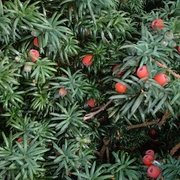Yew
|
|
| Yew | ||||||||||||
|---|---|---|---|---|---|---|---|---|---|---|---|---|
| Missing image TXbaccata.jpg European Yew (Taxus baccata) shoot with mature and immature cones | ||||||||||||
| Scientific classification | ||||||||||||
| ||||||||||||
| Species | ||||||||||||
|
Taxus baccata - European Yew |
Yews are small coniferous trees or shrubs in the genus Taxus in the yew family Taxaceae. They are relatively slow growing and can be very long-lived, and reach heights of 1-40 m, with trunk diameters of up to 4 m. They have reddish bark, lanceolate, flat, dark-green leaves 1-4 cm long and 2-3 mm broad, arranged spirally on the stem, but with the leaf bases twisted to align the leaves in two flat rows either side of the stem.
YewSeed.jpg
The seed cones are highly modified, each cone containing a single seed 4-7 mm long partly surrounded by a modified scale which develops into a soft, bright red berry-like structure called an aril, 8-15 mm long and wide and open at the end. The arils are mature 6-9 months after pollination, and with the seed contained are eaten by thrushes, waxwings and other birds, which disperse the hard seeds undamaged in their droppings; maturation of the arils is spread over 2-3 months, increasing the chances of successful seed dispersal. The male cones are globose, 3-6 mm diameter, and shed their pollen in early spring. Yews are mostly dioecious, but occasional individuals can be variably monoecious, or change sex with time.
All of the yews are very closely related to each other, and some botanists treat them all as subspecies or varieties of just one widespread species; under this treatment, the species name used is Taxus baccata, the first yew described scientifically.
MexYew.jpg
The most distinct is the Sumatran Yew (T. sumatrana, native from Sumatra and Celebes north to southernmost China), distinguished by its sparse, sickle-shaped yellow-green leaves. The Mexican Yew (T. globosa, native to eastern Mexico south to Honduras) is also relatively distinct with foliage intermediate between Sumatran Yew and the other species. The Florida Yew, Mexican Yew and Pacific Yew are all rare species listed as threatened or endangered.
All species of yew contain the highly poisonous alkaloid taxine, with some variation in the exact formula of the alkaloid between the species. All parts of the tree except the arils contain the alkaloid. The arils are edible and sweet, but the seed is dangerously poisonous; unlike birds, the human stomach can break down the seed coat and release the taxine into the body. This can have fatal results if yew 'berries' are eaten without removing the seeds first. Grazing animals, particularly cattle and horses, are also sometimes found dead near yew trees after eating the leaves, though deer are able to break down the poisons and will eat yew foliage freely. In the wild, deer browsing of yews is often so extensive that wild yew trees are commonly restricted to cliffs and other steep slopes inaccessible to deer. The foliage is also eaten by the larvae of some Lepidopteran insects including Willow Beauty.
Taxus_baccata_flowers.jpg
Uses and traditions
Yew wood is reddish brown (with whiter sapwood), and is very hard. It was traditionally used to make bows, especially the longbow. Consequently, it is not surprising that, in Norse mythology, the god of the bow, Ullr's abode had the name Ydalir (Yew dales). Most longbow wood used in northern Europe was imported from Iberia, where climatic conditions are better for growing the knot-free yew wood required. The Eihwaz rune ᛇ is named after the yew, and sometimes also associated with the "evergreen" World tree, Yggdrasil.
The European Yew Taxus baccata, also known as Common Yew or English Yew, is often found in churchyards; some are exceptionally large (over 3 m diameter) and likely to be over 3,000 years old, long predating the churches they are beside. It is likely that yew trees had a pre-Christian association with old pagan holy sites and many believe that the enormous sacred evergreen at the pagan Temple at Uppsala was a yew. The Christian church consequently found it expedient to use and take over these existing sites for churches. It is sometimes suggested that these were planted as a symbol of long life or trees of death. Another explanation is that the yews were planted to discourage farmers and drovers from letting their animals wander into the burial grounds, with the poisonous foliage being the disincentive.
English_Yew_600.jpg
Yews are widely used in landscaping and ornamental horticulture. Over 400 cultivars of yews have been named, the vast majority of these being derived from European Yew, Japanese Yew and the hybrid between them (Taxus x media). The most popular of these are the "Irish Yew" (Taxus baccata 'Fastigiata'), a fastigiate cultivar of the European Yew, and the several variants with yellow leaves, collectively known as golden yew.
The Pacific Yew Taxus brevifolia, native to the Pacific Northwest of North America, is the source of paclitaxel, a drug with apparent anti-cancer activity. Over-harvesting of the Pacific Yew for this drug has resulted in it becoming an endangered species, though the drug is now produced semi-synthetically from cultivated yews, without the need to further endanger the wild populations. Other yew species contain similar compounds with similar biochemical activity.
The yew tree is a frequent symbol in the Christian poetry of T. S. Eliot, especially his Four Quartets.
da:Taks (Taxus) de:Eiben eo:taksuso fr:If (Botanique) ja:イチイ nl:Taxus pl:Cis (drzewo)

